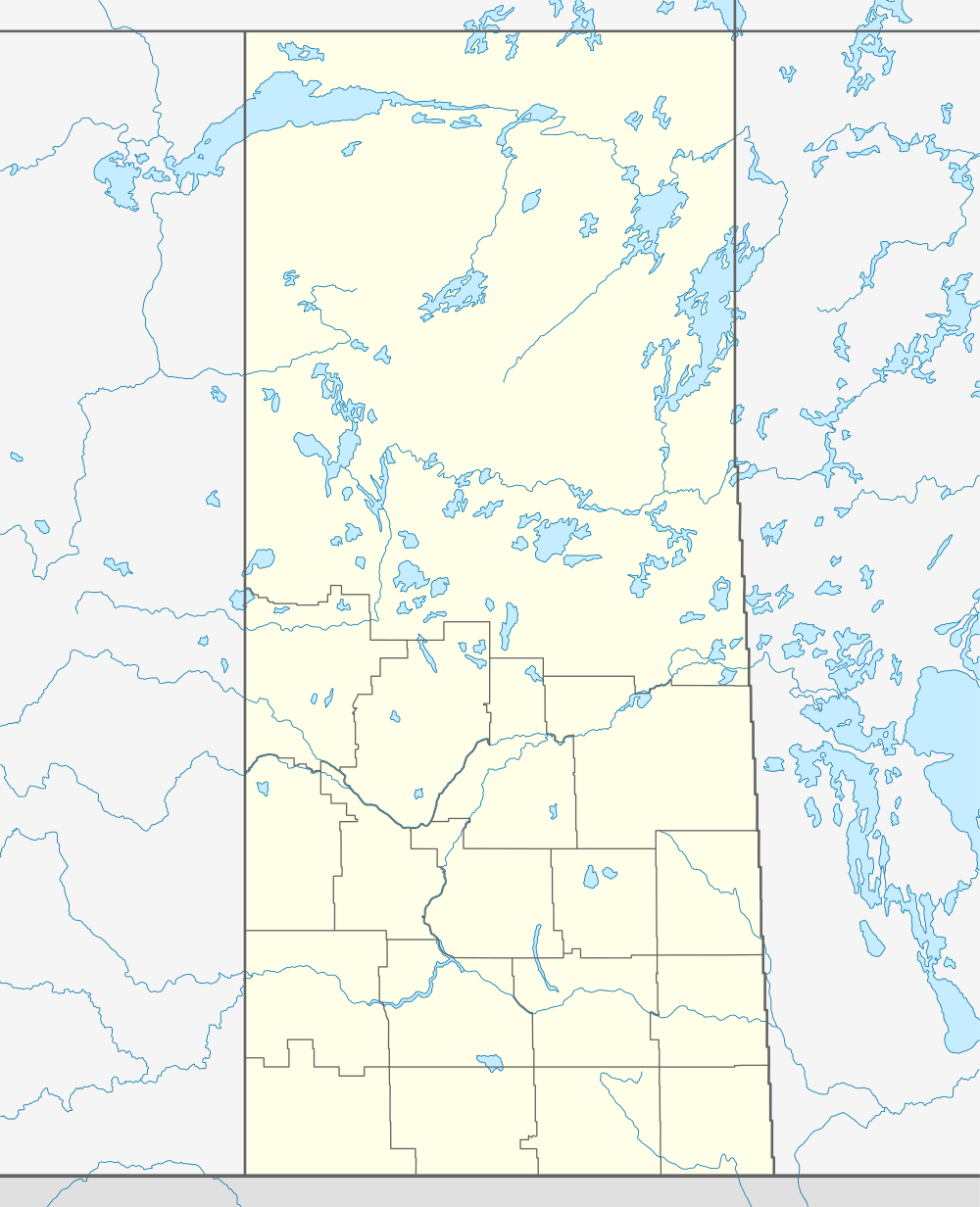Canora, Saskatchewan
| Canora | ||
|---|---|---|
| Town | ||
|
The "Welcome to Canora" statue "Lesia" | ||
| ||
| Motto: "Heart of Good Spirit Country" | ||
 Canora  Canora | ||
| Coordinates: 51°38′02″N 102°26′13″W / 51.63394°N 102.43691°W | ||
| Country | Canada | |
| Province | Saskatchewan | |
| Region | East Central | |
| Census division | No. 9 | |
| Rural Municipality | Good Lake | |
| Post Office Founded | 1904 | |
| Incorporated (Village) | 1905 | |
| Incorporated (Town) | 1910 | |
| Government | ||
| • Mayor | Terry Dennis (2009) | |
| • Town Manager | Michael Mykytyshyn | |
| • Governing body | Canora Town Council | |
| • M.P., Yorkton—Melville | Garry Breitkreuz (2011) | |
| • M.L.A., Canora-Pelly | Ken Krawetz (2011) | |
| Area | ||
| • Total | 7.31 km2 (2.82 sq mi) | |
| Elevation[1] | 487 m (1,598 ft) | |
| Population (2011) | ||
| • Total | 2,219 | |
| • Density | 303.7/km2 (787/sq mi) | |
| Time zone | CST (UTC-6) | |
| • Summer (DST) | CST (UTC-6) | |
| Postal code | S0A 0L0 | |
| Area code(s) | 306/639 | |
| Highways |
| |
| Railways |
Canadian National (freight), Via Rail (passenger) | |
| Waterways | Whitesand River Assiniboine River | |
| Website | Canora.com | |
| [2][3] | ||
Canora is located at the junction of highways No. 5 and 9 in East Central Saskatchewan.
Centrally located on the corners of four adjacent rural municipalities, the community is home to approximately 2,200 residents and draws upon a substantial trading area. Canora's name comes from the first two letters of the words "Canadian Northern Railway", as the original village was incorporated in 1905 around a station of the Canadian Northern Railway (CNoR). (A school in the village of West Jasper Place, Alberta, was named in the same way in 1948, with that name adopted by the surrounding neighbourhood of Canora, Edmonton.)
The CNoR was one of the companies that evolved into the Canadian National Railway Company (CN), and the CN freight line still runs through Canora. The Canora railway station, on the CN line, is served by Via Rail on its passenger service from Winnipeg to Churchill, Manitoba.
Demographics
Canora became a village in 1905 and was incorporated as a town in 1910.
| Canada census – Canora community profile | |||
|---|---|---|---|
| 2011 | 2006 | 2001 | |
| Population: | 2219 (10.2% from 2006) | 2013 (-8.5% from 2001) | 2200 (-0.8% from 1996) |
| Land area: | 7.31 km2 (2.82 sq mi) | 7.31 km2 (2.82 sq mi) | 7.29 km2 (2.81 sq mi) |
| Population density: | 303.7/km2 (787/sq mi) | 275.5/km2 (714/sq mi) | 301.7/km2 (781/sq mi) |
| Median age: | 52.1 (M: 50.3, F: 53.7) | 55.0 (M: 51.6, F: 57.3) | 52.0 (M: 48.7, F: 55.8) |
| Total private dwellings: | 1166 | 1142 | 1174 |
| Median household income: | |||
| References: 2011[4] 2006[5] 2001[6] | |||
| Year | 1906 | 1911 | 1921 | 1931 | 1941 | 1951 | 1961 | 1966 | 1981 | 1991 | 2001 | 2011 |
|---|---|---|---|---|---|---|---|---|---|---|---|---|
| Population | 169 | 435 | 1,230 | 1,179 | 1,200 | 1,563 | 2,117 | 2,737 | 2,667 | 2,381 | 2,200 | 2,219 |
Attractions
Canora is known as the "Heart of Good Spirit Country" as a result of its proximity to several lakes and parks, including Crystal Lake, Good Spirit Lake and Duck Mountain Provincial Park. The area is home to Saskatchewan’s greatest number of golf courses per capita and boasts one of the highest tee traffic counts in the province.
The town was judged to have the best-tasting municipal water in Canada at the 13th annual international water tasting competition held in 2003 in Bath (Berkeley Springs), West Virginia, USA. Canora’s water, supplied by several ground wells northeast of the community, also placed fourth internationally at the competition that received entries from eight countries and 23 states. Free samples of this great-tasting water are available at the CN Station House Museum during the summer months.
Protective Services
Canora is protected by the Canora-Sturgis RCMP detachment. The detachment has 8 members, between Canora and Sturgis.
Canora and area is served by a full-time Ambulance service – consisting of 3 PCP's, 3 ICP's, and two ACP's.
Canora's fire protection is provided by 21 professionally trained and certified paid-per-call staff. Along with fire protection they also provide rescue services such as vehicle extrication. Their services are also utilised in surrounding Rural Municipalities.
See also
References
- ↑ "The Atlas of Canada". Retrieved 2015-03-13.
- ↑ National Archives, Archivia Net. "Post Offices and Postmasters". Archived from the original on 2006-10-06. Retrieved 2014-03-20.
- ↑ Government of Saskatchewan, MRD Home. "Municipal Directory System". Archived from the original on 2016-01-15. Retrieved 2014-03-20.
- ↑ "2011 Community Profiles". Canada 2011 Census. Statistics Canada. July 5, 2013. Retrieved February 27, 2015.
- ↑ "2006 Community Profiles". Canada 2006 Census. Statistics Canada. March 30, 2011. Retrieved February 27, 2015.
- ↑ "2001 Community Profiles". Canada 2001 Census. Statistics Canada. February 17, 2012. Retrieved February 27, 2015.
- ↑ "Population of the Prairie Provinces, 1901,1906,1911 and 1916" (PDF). 2011. Retrieved 2015-02-27.
External links
 |
Preeceville | Amsterdam | Pelly |  |
| Buchanan | |
Veregin | ||
| ||||
| | ||||
| Good Spirit Lake | Yorkton | Wroxton |
